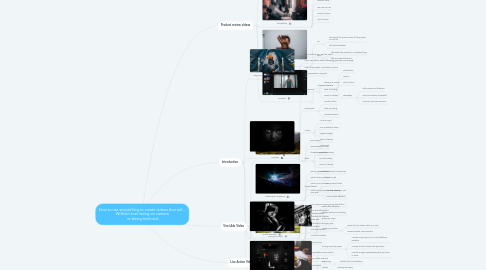
1. Viral Ads Video
1.1. Purpose
1.1.1. Ecommerce
1.1.2. Showcasing products
1.1.3. Showcasing services
1.2. Defining the audience
1.2.1. Who is your customer
1.2.2. What is their problem
1.2.3. What is your solution
1.2.4. What is your customer big aspiration and main goal
1.3. Writing the script
1.3.1. "The internet is going crazy about this..."
1.3.2. "Product description"
1.3.3. "Product star feature"
1.3.4. "Company is bringing you"
1.3.5. "Product benefits"
1.3.6. "Product benefits"
1.3.7. "Tag a friend"
1.4. Preparation
1.5. Production
1.5.1. Getting video clips
1.5.1.1. Writing down the script
1.5.1.1.1. use a blank document
1.5.1.2. Adobe Stock
1.5.1.3. Youtube
1.5.1.3.1. ask for permissions to use
1.5.1.3.2. ask to buy rights to use
1.5.2. Putting it all together
1.5.2.1. live demo in animoto
2. Live Action Videos
2.1. Preparation
2.1.1. Define the audience
2.1.2. Explain what you are selling
2.1.3. Define an angle
2.1.4. Finding a provider
2.1.4.1. search for live action video on Fiverr
2.1.4.2. recommended: Hernanarvelo
2.2. Writing the script
2.2.1. Writing scene by scene
2.2.1.1. narrate every scene in as much details as possible
2.2.1.2. include number of seconds per scene
2.2.1.3. include images representing what you have in mind
2.2.2. Beginning
2.2.2.1. set the tone and situation
2.2.3. Middle
2.2.3.1. develop the story
2.2.4. End
2.2.4.1. provide a satisfying conclusion
2.2.4.2. call to action
2.3. Demo
2.3.1. Script demo
2.3.2. Script download
3. Product review videos
3.1. Préparation
3.1.1. Review the product in depth
3.1.2. Brainstorm all possible producg uses
3.1.3. Choose target market
3.1.4. Pick one angle
3.2. Storytelling
3.2.1. Introduction
3.2.2. Personal story
3.2.3. OR How To Use
3.2.4. Product review
3.2.5. Call to action
3.3. Do and Donts
3.3.1. Do
3.3.1.1. talk about the practical use of the product in real life
3.3.1.2. talk about benefits
3.3.2. Dont
3.3.2.1. talk about the product in an abstract way
3.3.2.2. talk only about features
3.4. Example
3.4.1. VideoFlow Review
3.4.1.1. Introduction
3.4.1.2. How to
3.4.1.3. Call to action
3.4.1.4. Takeaways
3.4.1.4.1. Little mention of features
3.4.1.4.2. Lots of mentions of benefits
3.4.1.4.3. Focus on use case scenario
4. Introduction
4.1. Why you don't need to be on camera
4.1.1. It's not about you, but the client
4.1.2. If you can deliver without showing your face, it's enough
4.1.3. 99% of my videos I dont show my face
4.1.4. Less preparation required
4.2. How not to be on camera
4.2.1. Screencast
4.2.1.1. Share your screen
4.2.1.2. Start recording
4.2.1.3. Quick to deploy
4.2.2. Powerpoint
4.2.2.1. Create outline
4.2.2.2. Start recording
4.2.2.3. Somewhat quick
4.2.3. Actors
4.2.3.1. Write a script
4.2.3.2. Hire production team
4.2.3.3. Higher budget
4.2.3.4. Slow to deploy
4.2.4. Stock
4.2.4.1. Write script
4.2.4.2. Buy stock videos
4.2.4.3. Can feel cheap
4.2.4.4. Quick to deploy
4.2.4.5. Good alternative to screencast
4.2.5. Product shots
4.2.5.1. Write script
4.2.5.2. Get product shots
4.2.5.3. Quick to deploy
4.2.5.4. Social media effective
4.3. Course overview
4.3.1. product review videos
4.3.2. social media ads
4.3.3. live action videos
4.4. Why storytelling
4.4.1. Storytelling sublimes any content
4.4.2. Beginning Middle and End
4.4.3. The 3 act structure
